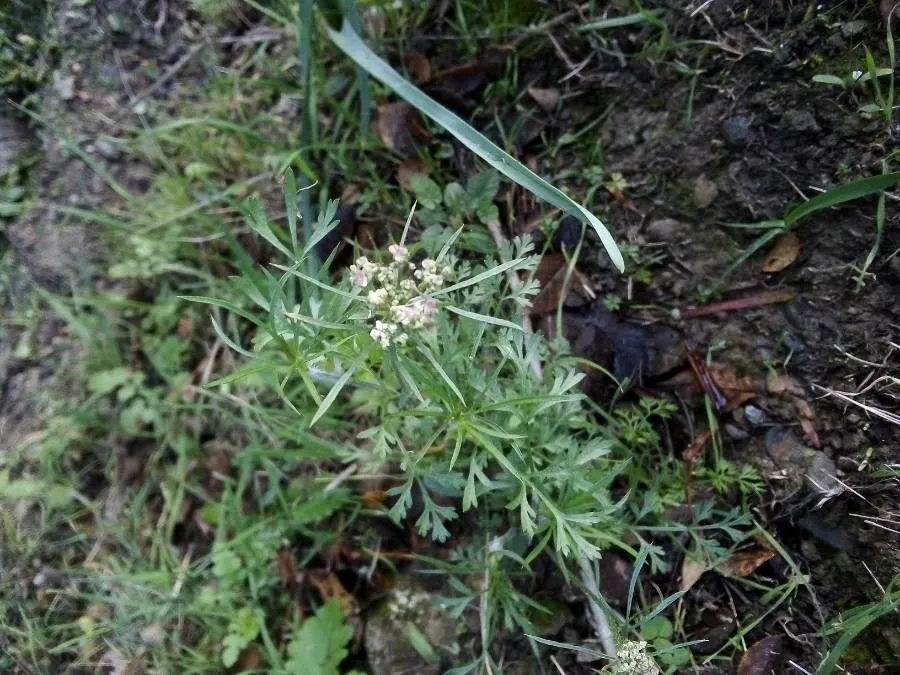
Author: L.
Bibliography: Sp. Pl.: 243 (1753)
Year: 1753
Status: accepted
Rank: species
Genus: Ammi
Vegetable: False
Observations: Macaronesia, Medit. to Iran and Arabian Pen.
Bishop’s-weed, scientifically referred to as Ammi majus, is a fascinating and versatile plant belonging to the Apiaceae family. This herbaceous species is recognized for its delicate and intricate floral structure that has captured the interest of botanists and gardeners alike.
First officially described by the renowned botanist Carl Linnaeus in 1753, Ammi majus finds historical mentions in Linnaeus’ seminal work, Species Plantarum, where it is cataloged under species number 243. The plant’s widespread popularity can be attributed to both its ecological adaptability and ornamental charm.
Bishop’s-weed thrives in a variety of climates and regions, notably spanning Macaronesia, the Mediterranean basin, stretching as far as Iran and the Arabian Peninsula. This geographic distribution underscores the plant’s resilience and ability to prosper in diverse environmental conditions, ranging from temperate locales to more arid terrains.
Botanically, Ammi majus is distinct within its family, Apiaceae, often going unchallenged in terms of its aesthetic appeal. The plant is characterized by finely divided leaves and umbels of petite, white flowers that form a visually captivating, lace-like pattern. These pearly white blooms not only serve as an appealing garden feature but are also important from an ecological perspective, providing nectar for an array of pollinators.
Beyond its ornamental uses, Ammi majus has been historically recognized for its medicinal properties. In traditional medicine, it has been utilized for its purported efficacy in treating various ailments, though contemporary applications often focus on its role as a beneficial companion plant in agricultural settings, where it attracts beneficial insects and aids in natural pest control.
In conclusion, Bishop’s-weed, or Ammi majus, is a botanical gem with a storied presence across multiple continents, from the lush landscapes of the Mediterranean to the deserts of Arabia. Its scientific and historical significance, coupled with its practical applications, make it a subject of continuing interest for both horticultural enthusiasts and professional botanists.
Dan: almindelig kongekommen, kongekommen, kongeskærm
Deu: bischofskraut, große knorpelmöhre, großes ammei, knorpelmöhre
Eng: bullwort, large bullwort, bishop’s-weed, false bishop’s-weed, greater ammi, laceflower, lady’s-lace, bishop’s weed, may weed
Lit: didysis amis
Spa: ameo bastardo, ameo mayor
Por: amio, amio-maior, bisnaga-das-searas
Hun: ammi
Fra: ammi élevé
Ara: khillah
Lav: liel
Ces: mora
Ita: rizzomolo, visnaga maggiore
Swe: slöjsilja
Est: suur ammi
Nld: groot akkerscherm
Cym: esgoblys
En: Bishop’s-weed, Bullwort, Greater ammi, Laceflower, False bishop’s-weed, Lady’s-lace, Large bullwort, Bishop’s weed, May weed, Bishop’s Flower, Bishopsweed, Large Bishop’s Weed, Ameo mayor, Cicuta-negra
Ar: Khillah
Ca: Àbit bord, Siscla
Cs: Mora
Da: Almindelig kongekommen, Kongekommen, Kongeskærm
Nl: Groot akkerscherm
Et: Suur ammi
Fr: Ammi élevé, Ammi commun, Ammi officinal, Grand Ammi, Ammi inodore
De: Bischofskraut, Große Knorpelmöhre, Großes Ammei, Knorpelmöhre, Grosse Knorpelmöhre
He: אמיתה גדולה
Hu: Ammi
It: Rizzomolo, Visnaga maggiore
Lv: Liel
Lt: Didysis amis
Pt: Amio, Amio-maior, Bisnaga-das-searas, Gertrudes
Pt-br: Bisnaguinha-do-campo, Cicuta-negra, Âmio-maior
Es: Ameo bastardo, Ameo mayor, Aneto bastardo, Falsa Viznaga
Sv: Slöjsilja
Cy: Esgoblys
© copyright of the Board of Trustees of the Royal Botanic Gardens, Kew.
© copyright of the Board of Trustees of the Royal Botanic Gardens, Kew.
© copyright of the Board of Trustees of the Royal Botanic Gardens, Kew.
Taken Apr 3, 2021 by Salvatore Ciccarese (cc-by-sa)
Taken Jun 26, 2018 by corrado (cc-by-sa)
Taken Jun 5, 2019 by selber pflanzen (cc-by-sa)
Taken Jul 19, 2017 by Justine Dehayes (cc-by-sa)
Taken May 18, 2018 by Mariam Martin (cc-by-sa)
Taken Jul 11, 2021 by Jean Christophe Leroux (cc-by-sa)
Taken Aug 18, 2022 by Scholz Fabian (cc-by-sa)
Taken Jun 6, 2022 by Paula Lirola Gómez (cc-by-sa)
Taken Aug 31, 2021 by Ugoline Jacquot (cc-by-sa)
Taken Aug 3, 2020 by Ziv Paz (cc-by-sa)
Taken Jul 10, 2007 by Tela Botanica − John DE VOS (cc-by-sa)
Taken Aug 24, 2012 by Tela Botanica − Bertrand BUI (cc-by-sa)
Taken Sep 11, 2022 by Annemarie Ahrens-Stehle (cc-by-sa)
Taken Apr 6, 2022 by guasch vicente (cc-by-sa)
Taken Aug 31, 2021 by Ugoline Jacquot (cc-by-sa)
Taken May 4, 2014 by Tela Botanica − Patrick LEBOULENGER (cc-by-sa)
Taken Jul 2, 2019 by Marcello Di Manno (cc-by-sa)
Taken Jul 10, 2007 by Tela Botanica − John DE VOS (cc-by-sa)
Taken Jan 15, 2020 by thierry vidoy (cc-by-sa)
Taken Jun 6, 2022 by Paula Lirola Gómez (cc-by-sa)
Taken Mar 14, 2022 by Abdul Ghaffar (cc-by-sa)
Taken Apr 27, 2022 by Dieter Schwartz (cc-by-sa)
Taken Jul 18, 2022 by Frgt10Athrty (cc-by-sa)
Taken Nov 30, 2011 by EOL − Steve Matson (cc-by-nc)
Taken Oct 3, 2019 by Tela Botanica − Laurent Richin (cc-by-sa)
Taken Jan 1, 1970 by Photoflora – L’Abbé COSTE (©)
Taken Aug 24, 2014 by Tela Botanica − Vincent LEJEUNE (cc-by-sa)
Taken Jul 29, 2013 by Tela Botanica − Daniel CAHEN (cc-by-sa)
Taken Jul 15, 2000 by Photoflora – Benoit BOCK (©)
Taken Jul 25, 2008 by Tela Botanica − Mathieu MENAND (cc-by-sa)
Growth habit: Forb/herb
Ph maximum: 8.0
Ph minimum: 7.5
Light: 7
Atmospheric humidity: 4
Bloom months: [‘jul’, ‘aug’, ‘sep’]
Soil nutriments: 7
Family: Myrtaceae Author: (F.Muell.) K.D.Hill & L.A.S.Johnson Bibliography: Telopea 6: 402 (1995) Year: 1995 Status:…
Family: Rubiaceae Author: Pierre ex A.Froehner Bibliography: Notizbl. Bot. Gart. Berlin-Dahlem 1: 237 (1897) Year:…
Family: Sapindaceae Author: Koidz. Bibliography: J. Coll. Sci. Imp. Univ. Tokyo 32(1): 38 (1911) Year:…
Family: Asteraceae Author: A.Gray Bibliography: Pacif. Railr. Rep.: 107 (1857) Year: 1857 Status: accepted Rank:…
Family: Fabaceae Author: Medik. Bibliography: Vorles. Churpfälz. Phys.-Ökon. Ges. 2: 398 (1787) Year: 1787 Status:…
Family: Aspleniaceae Author: (Cav.) Alston Bibliography: Bull. Misc. Inform. Kew 1932: 309 (1932) Year: 1932…